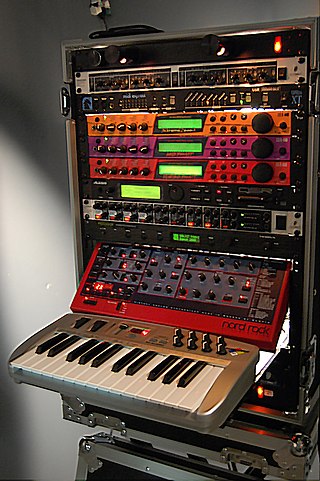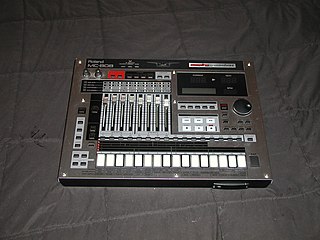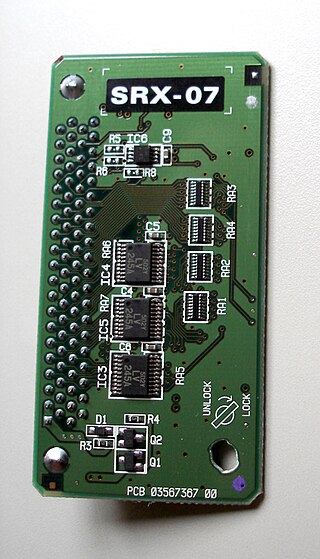
MIDI is a technical standard that describes a communication protocol, digital interface, and electrical connectors that connect a wide variety of electronic musical instruments, computers, and related audio devices for playing, editing, and recording music.

A groovebox is a self-contained electronic or digital musical instrument for the production of live, loop-based electronic music with a high degree of user control facilitating improvisation. The term "Groovebox" was originally used by Roland Corporation to refer to its MC-303, released in 1996. The term has since entered general use, and the concept dates back to the Movement Computer Systems Drum Computer in 1981.
A music workstation is an electronic musical instrument providing the facilities of:

A sampler is an electronic musical instrument that records and plays back samples. Samples may comprise elements such as rhythm, melody, speech, sound effects or longer portions of music.

The Roland MC-303 is the first of a series of musical instruments known as a groovebox. It combines a simple sound module with a sequencer to record and store notation, along with controls aimed at encouraging the musician to improvise the music while it is playing. Despite the number in its name and the attention it received at its launch, the MC-303 has more in common with other MC prefixed synthesizers, which contain built-in sequencers, than it does with the famous Roland TB-303. As the first Groovebox, the MC-303 was the first in a line of inexpensive products specifically targeted towards house DJs and amateur home musicians rather than professional producers. It was superseded by the Roland MC-505. It is the predecessor to the Roland JX-305, Roland D2, Roland MC-307, Roland EG-101, Roland MC-09, Roland MC-909, Roland MC-808, and most recently the Roland MC-707 in 2019, along with its more portable sibling, the Roland MC-101.

The Yamaha QY10 is a hand-held music workstation produced by the Yamaha Corporation in the early 1990s. Possessing a MIDI sequencer, a tone generator and a tiny single-octave keyboard, the portable and battery-powered QY10 enables a musician to compose music while traveling.

The Roland MC-505 is a groovebox conceived in 1998 as a combination of a MIDI controller, a music sequencer, a drum machine, and a desktop synthesizer with many synthesis features: arpeggiator, oscillators, and voltage-controlled filter, control of attack, decay, sustain and release, different envelopes and 2 Lfo. It was released as the successor to the Roland MC-303 and is a compact version of the Roland JX-305 Groovesynth without the full set of 61 keys. It is also the predecessor to the Roland D2, Roland MC-307, Roland MC-909 and the Roland MC-808.

The Yamaha Motif is a series of music workstation synthesizers, first released by Yamaha Corporation in August 2001. The Motif replaced the EX series in Yamaha's line-up and was also based on the early Yamaha S series. Other workstations in the same class are the Korg Kronos and the Roland Fantom G. The series' successor is Yamaha Montage.
The Fantom-X (Xa/X6/X7/X8/XR) is a music workstation/synthesizer produced by Roland Corporation. It was introduced in 2004 as an upgrade from the Fantom S series. The Fantom-X competes with the Korg Triton/Triton Extreme, the Yamaha Motif ES and other similar large-scope keyboards such as the discontinued Alesis Fusion. In 2008 it was succeeded by the Fantom-G*, which was devised to compete with the new Korg and Yamaha flagship keyboards.
The Ensoniq TS-10 was a synthesizer and music workstation introduced by Ensoniq in 1993. It provided synthesis, user sample playback, sequencer, effect units and performance facilities in a 61-key package.

The Roland MC-808 was a groovebox, announced at the Winter NAMM in 2006. It is the successor to the late Roland MC-303, Roland MC-307, Roland MC-505 and Roland MC-909.
The Yamaha SY85 is a digital music workstation introduced in 1992. Unlike other Yamaha synthesizers of the time the SY85 does not use FM synthesis. Instead, its sounds are based on samples, which can be layered and modified to create new sounds.

The Roland XP-80 is a music workstation that uses digital PCM subtractive synthesis and combines an updated version of the JV-1080 synthesizer engine with the sequencer capabilities of the Roland MRC-Pro sequencer. The XP-80 was introduced in 1996 and is now discontinued.

Roland Juno-G is a music workstation/synth introduced in 2006 by Roland Corporation. It is based on the Fantom-X series, having a vintage design that resembles the first Juno synthesizers, such as the Juno-106. The Juno-G's main competitors in the approximate price range, with similar features, when first released, were the Korg Triton Le/TR and Yamaha MO6 workstation synthesizers.

The SRX are a series of expansion boards produced by Roland Corporation. First introduced in 2000, they are small boards of electronic circuitry with 64MB ROMs containing patches (timbres) and rhythm sets. They are used to expand certain models of Roland synthesizers, music workstations, keyboards, and sound modules.
The Yamaha V50 is a hybrid music workstation introduced in 1989. It combines a sequencer, rhythm machine, an FM synthesis-based sound module and a MIDI keyboard.

The Roland XP-50 is a music workstation that combines the synthesizer engine of Roland's JV-1080 sound module with the sequencing capabilities of their MRC-Pro sequencer and a 61-note keyboard. First released in 1995, the XP-50 and the Roland XP-10 were the first two Roland XP-series products, later joined by the XP-80 and XP-30.

The Sirius is a keyboard "groove-synth," featuring a subtractive hybrid-tone-generation synthesizer referred to as DTE synthesis introduced in 1997 by Quasimidi. The unit featured both real-time and step sequencers with pattern- and song-modes, capable of acting basic drum machine, groove-box, or sound-module.
The Roland D2 Groovebox is a performance-oriented Groovebox. It has Roland's D-Field Controller technology. It has all of the Roland MC-505 sounds and a similar sequencer. All of the MFX effects have sub-menus. The D2 has 100+ sub-menus to sub-sub-sub-menus, and this is why it has fewer buttons than other Grooveboxes.













